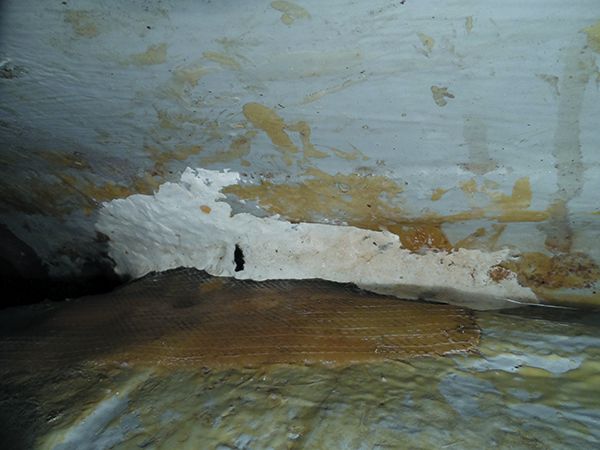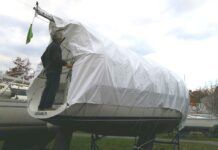
possible once the leak was stopped.
Sometimes a little more reinforcement is needed, but sometimes it can only be applied from outside. “Laminating underwater—that’s lunacy!” you say. Maybe. But using a few of the right tricks, you can make a pretty serviceable patch that should sail far.
- Laminating resin. It must be relatively thin and capable of both bonding and curing underwater. West Systems G-Flex will do that.
- Cloth. You want to do this in one layer, so you need something that both conforms well and builds some strength. Two layers of 1708 biaxial fiberglass is a good choice.
- Prepare the surface. Bottom paint needs to be sanded off to bare fiberglass. Use course wet/dry sandpaper.
- Pre-wet the cloth on dry land. This is the key. Pour the resin onto the cloth, spread, and work through the cloth using a laminating roller. Ideally, this is done on top of peel ply, but a plastic trash bag will work perfectly well in a bind.
- Apply. With the peel ply still in place, dive under the boat and press firmly over the desired area. Working from the center, slowly work your way outwards to make a good bond. Leave the peel ply in place.
There are two reasons for using peel ply. One is for ease of handling in the water. Although we usually work pre-laminated cloth without peel ply on dry land, it makes handling it in the water much easier. Because the cloth will initially stick to your hands more than the boat, the peel ply makes the patch much easier to apply. Finally, if there is still some inward leakage, the peel ply prevents the water flow from blowing the resin through the cloth and creating leaks.
Once resin is cured, you can remove the peel ply if you want to, but there’s really no need to for an emergency repair, other than to inspect your work. Just leave it.
You can buy a kit for this (compositepatch.com). It comes prepackaged, with resin and fabric in a bag. At over $250 for a few square feet it’s rather expensive, but it makes for neat work in awful conditions.

































